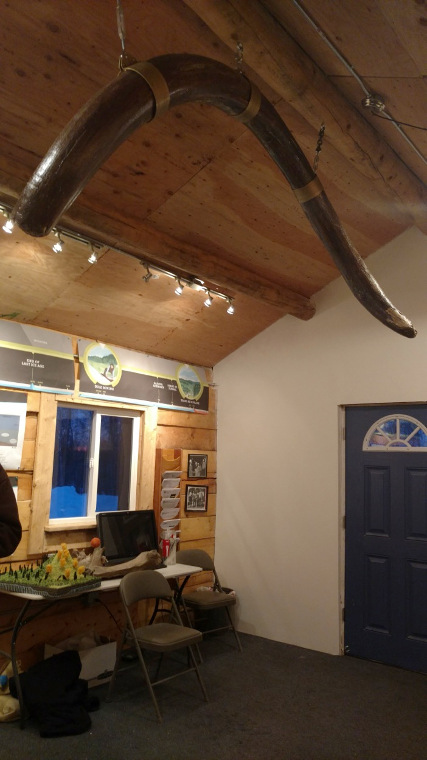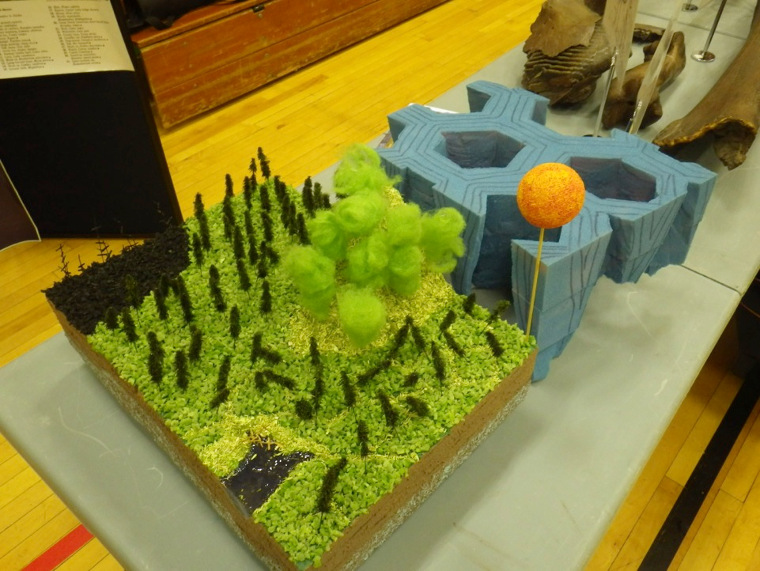The Hidden World of Permafrost: Bringing Visitors into a Real and Fascinating Subterranean World
Ten miles north of Fairbanks, Alaska, a tunnel penetrates a hillside covered by small black spruce trees. The tunnel was built in the 1960s by the U.S. Army Corps of Engineers. For more than 50 years the Permafrost Tunnel has supported cutting-edge research on permafrost, and in addition has seen a steady stream of visitors ranging from 2nd graders, to Senators and former Presidents of the United States, including Jimmy Carter. All of this attention in spite of the fact that the tunnel is dim, dusty, cold and smells like a barnyard. Part of the tunnel’s attraction seems to come from the dozens of bones of extinct Pleistocene mammoths and bison frozen into the walls; and part of the appeal seems to be from the huge dark ice wedges and strange ice features—called thermokarst cave ice—seen in cross section as one walks through the tunnel, and the relics exposed by the tunnel excavation, including frozen plants that were buried 30,000 years ago and that are still green today. Among scientific and non-scientific communities alike, the tunnel is justly famous because it is the only such tunnel, and what it holds in its frozen walls is amazing.
Between 1987 and 2012, I was a researcher with the U.S. Army Cold Regions and Engineering Laboratory-Alaska (the operators of the tunnel). During that period I gave hundreds of tunnel tours for military and civilian leaders, for the general public, and the media. The tunnel never failed to engage and fascinate its visitors. Why? Was it that the environment of the tunnel is so evocative and memorable? Was it that visitors could touch real 15,000-year-old bones, or see ice that contains bacteria that is still viable 40,000 years after it was frozen? For all those years of giving tours, it was clear the tunnel was a fascinating and engaging place, but it was not clear why.
It was to answer that question that I sought out Laura Conner, a science education researcher at the University of Alaska (where I now work). We developed a proposal to explore the power of real objects and immersive experiences in free-choice science learning. I wanted to know what about this particular tunnel was so engaging. The project expanded in collaboration with the Oregon Museum of Science and Industry (OMSI) to build a traveling exhibition on permafrost, under the direction of Victoria Coats. With the addition of evaluators from the Goldstream Group under the lead of Angela Larson, our team was complete. The result is our on-going NSF-AISL project called “Hot Times in Cold Places: The Hidden World of Permafrost” (Award Nos. 1423550, 1423587).
Permafrost plays a critical role in global climate change, mainly because a vast amount of carbon is frozen in the permafrost, about twice the carbon present in the atmosphere. If this carbon was released, it would greatly increase greenhouse gas loading. Unlike glaciers and sea ice, permafrost is difficult to visualize since it is underground, and therefore it can be hard to understand. It is also endangered. In many places permafrost is thawing rapidly, and should the earth start to cool now, it would take thousands of years for it to return, unlike sea ice, Most of the permafrost around today was made over a 40,000-year period during the last Ice Age. Introducing this hidden but critical world to more people is important to us, and we are going about it by sharing real objects in our displays like real bones, and real slices of 30,000 year old ice. We also trying to understand what aspect of “realness” holds the power to engage and help people learn.
Our project team has three main tasks: 1) improving the experience for visitors at the Permafrost Tunnel through new interpretive material, while conducting research and evaluation on why and how real objects in the tunnel contribute to learning, 2) taking the Permafrost Tunnel “on the road” by traveling throughout the state of Alaska to visit dozens of remote native villages with permafrost ice, Pleistocene bones and personal enthusiasm, and 3) creating a traveling museum exhibition on permafrost and climate change that will tour the lower 48 states for about 8 years. We are in our second year of the grant, with two more to go.
Our approach is informed by visitor studies and special family events we have held at the tunnel and at OMSI. Front-end surveys show visitors are hungry for more information about permafrost, and have a general, though shaky, understanding of climate change and permafrost’s role in it. We have noted in our findings that Alaskan participants are more focused on how to adapt to climate change since the effects are already very real and present in the northern landscape. In comparison, Oregonians are more focused on mitigation, such as finding ways to decrease carbon emissions. We also noted, though not surprisingly, that Alaskans are more knowledgeable about the Ice Age, permafrost, and the Arctic in general, than their Oregonian counterparts, which suggests some challenges in designing a traveling exhibit that would effectively reach different audiences in the lower 48 states.
With our audiences in mind, we aim to design an exhibit that will spark interest and curiosity, and that will encourage visitors to use inquiry and empathy when learning about permafrost. We hope visitors will discover that permafrost is old (tens of thousands of years), cold (below freezing), huge (1/4 of the earth’s land surface), and now thawing so fast that it will change the world. Building on what we have learned from our front-end surveys, we now begin to investigate how to evoke emotional responses of caring and value from visitors who view the exhibition. Are visitors making personal connections to this ancient, hidden world of permafrost? Can we motivate visitors to take positive action?
To date the project team has visited more than a dozen villages across Alaska, many of them native villages that have traditionally been underserved when it comes to such learning opportunities. While the number of people these visits have engaged is small compared to the number of visitors coming to an urban science museum, the several thousands of miles we have traveled doing the outreach covers a vast swath of the state and the warm welcome we have received in every village has been encouraging. Meanwhile, new interpretive displays at the tunnel and its adjacent visitor cabin are steadily taking shape, which will make this science more accessible for 2nd graders and policy makers alike. The nationally traveling exhibition should debut at OMSI in fall of 2017.
The project has been something of a personal odyssey for me. During my 36 years of field research in Alaska and the Arctic, I have frequently engaged with the residents of tiny and remote communities on science, but I never felt like I really knew what I was doing. Now on this project I am surrounded by great people who know and understand the world of informal STEM learning;their enthusiasm and knowledge is flowing back to me in ways that are improving my role as a science ambassador.
Figure 1: A mammoth tusk collected from near the Permafrost Tunnel has been hung in the cabin at the tunnel site as part of our improvements in visitor displays and materials at that location. The tusk weighs over 200 lbs.

Figure 2: We use models of permafrost landscapes and ice wedges (foreground) as well as real 12,000 year-old mammoth teeth (background) in the displays we take to remote Alaskan villages.

Figure 3: At Science Night in a remote Alaskan village, kids make and wear wooly mammoth masks.
